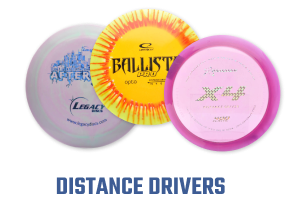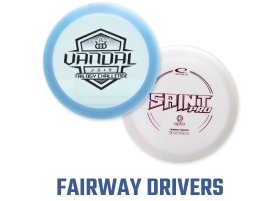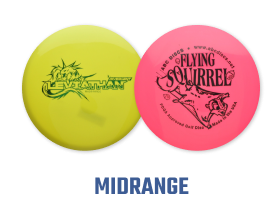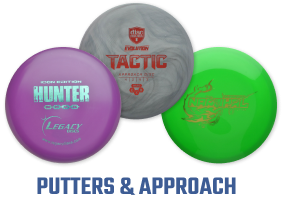
When stepping into the world of disc golf a little knowledge goes a long way. Disc manufacturers produce a multitude of discs with various flight patterns and characteristics. But with all of these manufacturers and types of discs, where do you start? You are in the right place. This article will break down the characteristics of discs and give recommendations as to which discs will work for you. As you read, it is best to be honest with yourself as to your skill level in the game. This will help you choose discs that will benefit your throwing style. Let’s get to it!
Types of Discs
Discs can be broken down into three categories: drivers, mid-ranges and putters. Drivers are used for your long-distance shots. Mid-ranges are used for precision shots when attacking the basket from a shorter distance. Putters are used when in close proximity to the basket. For a beginner, I recommend having at least one of each of these discs. This will allow you to begin thinking about flight characteristics and which disc would be best for each shot. Disc golf is a wonderful sport in that it allows the player to be creative with their shot shaping. There is no correct way to get from point A to point B – get creative out there!
Characteristics of a Disc
Below will be definitions and descriptions of various aspects of a disc. Get to know these and why they may benefit a certain throwing style over another. Every disc has a rim around the perimeter and a flight plate that fills the space inside the rim.
- Stability- For a Right Handed Backhand (RHBH) throw an overstable disc will finish left while an understable disc will finish right. These terms will be used liberally to describe discs.
- Plastics- All manufacturers have various plastics that their discs will be made in. For example, Innova plastics include: Star, StarLite, Echo, Gstar, Champion, Metal Flake, Blizzard, XT, Driver Pro, KC Pro, R Pro, JK Pro and DX. Each mold of disc will be made in a variety of plastics. A rule of thumb is the softer the plastic the more understable it will be.
- Weights- Discs come in a variety of weights, measured in grams. Max weight is 180 grams and will make a disc more overstable. A good way to bring more distance into your game as a beginner is to throw lower weight discs. I recommend anywhere between 150 g-165 g. This will neutralize slower arm speeds and allow the disc to travel further without as much effort.
- Bead- This is a small molded ridge that is on the bottom side of the rim. Players like beads because the disc rests deeper in the crease of the finger. This in turn creates more velocity and spin resulting in more distance. Beads vary in size so give the rim a squeeze and see if a bead feels comfortable for your grip.
- Flight Numbers- Flight numbers are a way to visualize the flight of a disc throughout the entirety of its path. There are four metrics used for each disc: speed, glide, turn, and fade. The two most important numbers for a beginner are speed and turn. You want a disc that will fly straight and not turn too hard to the left or right. I recommend no faster than a 6 speed and a turn rating of -1 to -3. This will allow you to use the proper form and still get distance. As you produce more spin through your throwing motion you can continue to progress up in speed as well as turn. A further explanation of the flight ratings system can be found here.
The bottom line here is make sure the disc feels comfortable in your hand. Hang out with friends and see what they are throwing. Talk to folks at the course. Feel the rim of the disc and get to know the various plastics and see what feels comfortable. In the beginning just be sure to choose discs that are understable with low turn and high glide numbers.
One point of caution. Just because the Pro’s are throwing a certain disc does not mean that you should be throwing it. In fact, quite the opposite. If you are new to the sport take a breath with me and say this: “I am not a professional disc golfer.” Whew, that was easy! While you may certainly want to progress, throwing the discs that the professionals throw without their skill and technique will have disastrous results. However, you may just be there someday.
Picking the Right Disc
There are many disc manufacturers out there. It can be a daunting task to try to consolidate all this information and pick the perfect disc for you. Do not despair! Choose one manufacturer and stick to them (at least in the beginning). This will narrow down your disc choices. Some of the current top disc manufacturers are Innova, Discraft, Dynamic Discs, and DGA.
Let’s choose one of the larger manufacturers: Innova. They manufacture over sixty discs that come in all types of plastics, molds, weights, and special editions. That is a lot of options from only one manufacturer.
Let’s narrow it down to three discs: one driver, one mid-range and one putter. I recommend getting a Leopard (driver), Stingray (mid-range), and an Aviar (putter). All of these discs are understable with high glide (i.e., they will stay aloft for a longer distance). They will all be easier for beginners to throw straight shots with and improve consistency.
Many manufacturers also have what are called “starter packs.” I highly recommend starting with these as they are geared towards beginners and will have the perfect blend of flight characteristics. Most starter packs come with three discs: one driver, one mid-range and one putter. They cost anywhere from $20-$40 depending on quality. These take the long-winded thought process out of choosing discs and get you on the course quicker.
Discs will also beat in over time and slowly turn more understable. For a RHBH this means the disc will have a tendency to turn right. For this reason it is recommended to get fresh discs in your bag from time to time. You can keep the old ones in there as well which gives you the opportunity to throw a wide variety of shots. Pros will typically carry anywhere from 20-30 discs due to all of the subtle differences in flight characteristics. Their best flying discs may even earn a nickname – this is highly recommended!
Conclusion
Enjoy the process as the world of discs opens to you. One of the best aspects of disc golf is that the entry into the sport is extremely accessible. For a reasonable price you can be out on the course enjoying nature and all its bounty with your new plastic in hand. Shop Rogue Discs for all of your disc needs and remember to have some fun out there!




